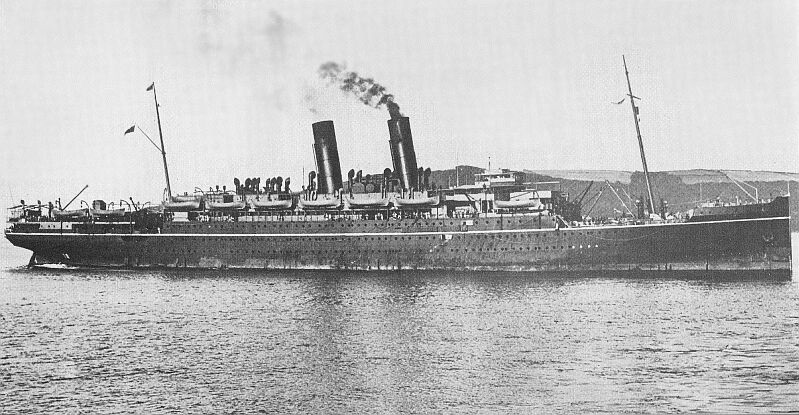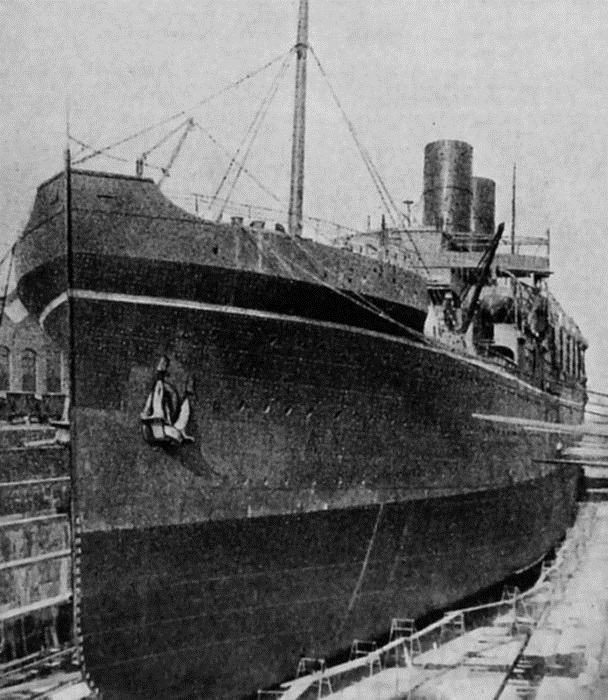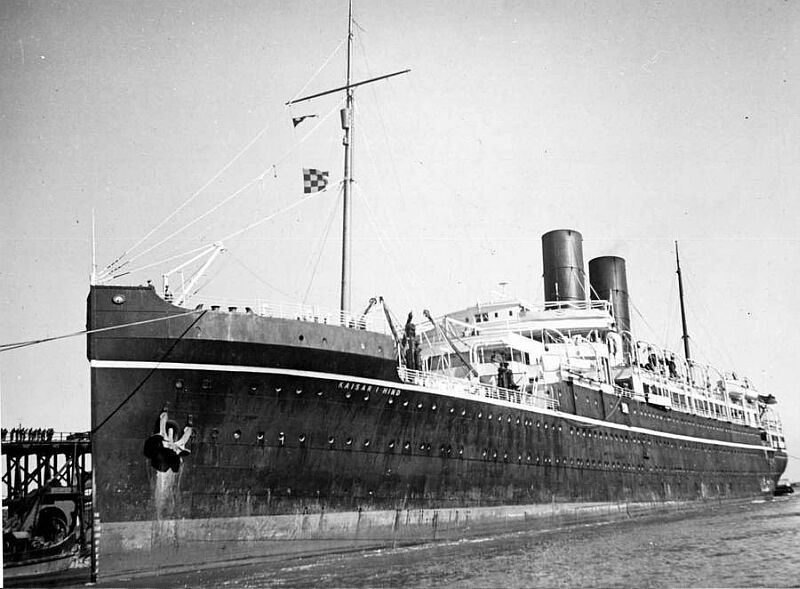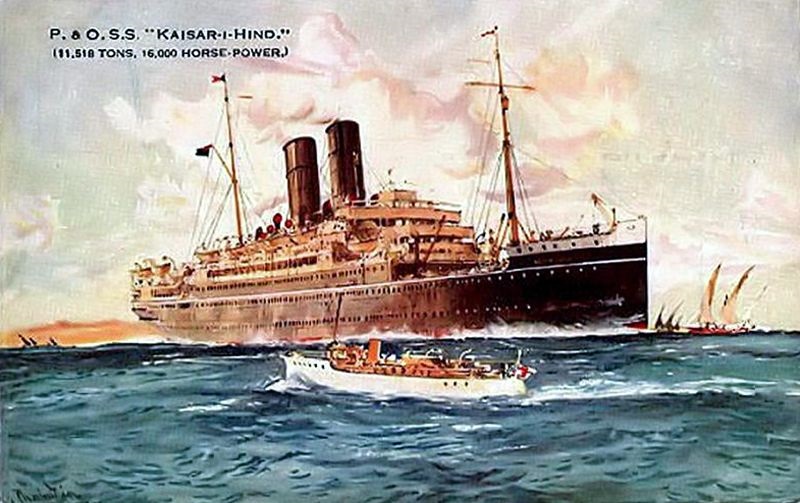[The Kaisar-i-Hind was in all probability their steamship of choice as Peter, Jean and their family travelled between Bombay and London from late 1914 until Peter's retirement in the early 1930's. I've reproduced these pictures and text for fear that this remarkable historical tribute will go missing like so many others have done over the last few years. But meanwhile there is much much more to enjoy on the original website.]
www.ssmaritime.com/Kaisar-I-Hind.htm
With Reuben Goossens
Maritime Historian, Cruise'n'Ship Reviewer, Author & Maritime Lecturer
Peninsular and Oriental Steam Navigational Company – P&O RMS Kaisar-i-Hind (2)
"Kaisar-i-Hind" is a Hindi name meaning "Empress of India"

An artist impression of the RMS Kaisar-i-Hind after 1926.
Postcard from the author's private collection
Introduction
As the "Peninsular and Oriental Steam Navigation Company" (P&O) required a new liner to operate on the profitable Indian Continent service, they required a new ship that would be built and designed exclusively for this service. With plans of their new warm weather ship completed, P&O placed and ordered the 11,430 GRT (Gross Registered Ton) liner on November 11, 1913 to be built by "Caird & Company Ltd" at Greenock, Scotland.
Her keel was soon laid down in Yard number 327, but amazingly, she remained a ship without a name although it was thought by many that she would be named "Taj Mahal," but that was not to be! As her hull and part of her superstructure had been completed, she was launched on June 28, 1914 by a Miss Edith Cole yet she remained without a name, thus the unnamed ship was taken to her fit-out berth for completion.
When completed she was showing off her traditional P&O livery being a black hull with red boot topping, a white ribbon around the hull, and her superstructure in what I personally consider a horrid and dull buff paint. All this was topped by two tall black funnels and a pair of masts, but what was interesting is that the masts were assisted by electric cranes, both fore and aft.
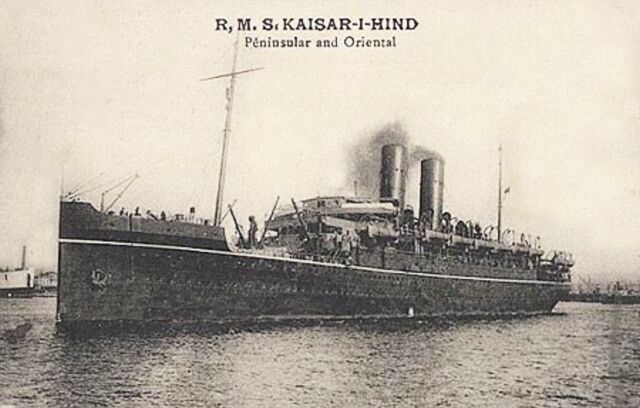
This is the very first photographic postcard of the RMS Kaisar-i-Hind that was ever released. She is seen here departing Tilbury.
Postcard from the author's private collection
Once her fitting out being fully completed, on October 1, 1914 the now named Kaiser-i-Hind departed for her deep-sea trials, which proved to be most successful. Instead of returning to the yard, she continued to London making this her delivery voyage. She was built at a cost of for what was in those days a massive amount of £363,176, being the old British pounds. In addition you might say that she was built to be a genuine passenger liner, as she did not carry a great deal of cargo for a ship of her size, no more than just 6,313 cubic metres or 222,980 cubic feet, however, it was sufficient for her needs!
Her Maiden Voyage and her life at sea has commenced
RMS Kaisar-i-Hind departed London on October 24 bound for Bombay India. Apparently due to her remarkable speed she arrived in Bombay in the record time. From the beginning she proved to be very popular liner with the travelling public with both classes as she very quickly gained a reputation for being a comfortable ship to sail on and she was perfectly designed for the hotter climes! But more so, service on board was typically P&O, simply superb as was the cuisine and all the many excellent facilities available to both classes.
The ship
What can I say about the Kaisar-i-Hind, do I consider her an attractive and beautifully designed passenger liner, thus a stylish and an elegant looking liner? To be completely honest my answer is, although I dearly love this great liner and I honestly wish I could have sailed on her, but to be honest she was externally she was as ugly as can be! In addition, not having promenades and her decks being all over the place, her livery certainly did not help her looks at all! What on earth made P&O ever decide on painting their ships superstructures in that most depressing colour, if you can even call it a colour?
However, and there is no doubts about it her interiors were the complete opposite to her externals, for she had some of had some the most beautiful and luxurious Lounges, Dinning Rooms and Accommodations for her 548 passengers, who were accommodated as follows: 315 passengers in First Class and 233 passengers in Second Class. One of the new features of the day were all those most welcome electric fans that were fitted in the public venues and all suites, luxury staterooms, and cabins on board regardless of class and passenger or crew, which made sailing on those hot steamy days and nights so much more bearable!
First Class featured some elegant lounges having beautifully timbered clad walls with high arched ceilings that went up into the deck above in several venues. Below is a photo gallery of her wonderful facilities and for her days, they were rather special for what was considered a small liner.
Photo Gallery
Some of the photographs below were provided by "Chris" who discovered my page online and he contacted me per email. He told me that his father had sailed on the RMS Kaisar-i-Hind in 1935 and He had sent home a "Letter-Card," and on the back there were four photographs of the First Class Venues, he was a first class passenger himself. Second Class passengers received their own folder, and I wish I could locate one. These are the oblong images below. But Chris did not wish to receive any credit, thus, it is just "Chris" but I am most appreciative to him!
The other photographs were sent to me recently by a regular ssMaritime supporter from the UK, and once again thank you very much for these superb images for the quality of these are delightfully surprising! Thus thank you once again Chris and Jason Bonner!
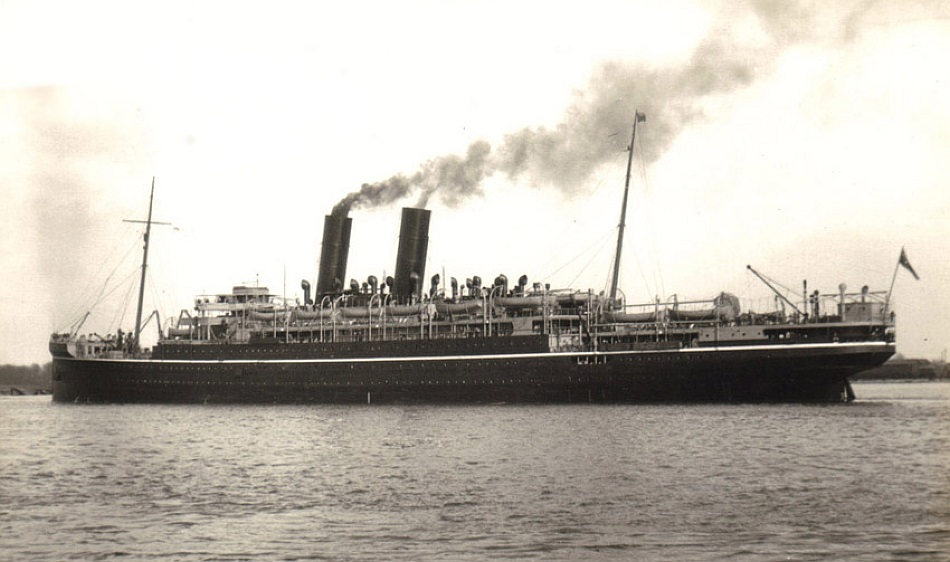
An excellent stern view of the delightful Kaisar-i-Hind.
Photograph from the Author's Private collection

The superbly elegant Main Lounge, only just reveals the dome in the centre of the room in this photo.
Sent in by Chris

The Music Room was a delightfully spacious venue with facilities for writing with desks. In addition there was a lounge ideal to listen to the piano or the trio. The balustrade looked down one deck.
Photograph kindly provided by Jason Bonner
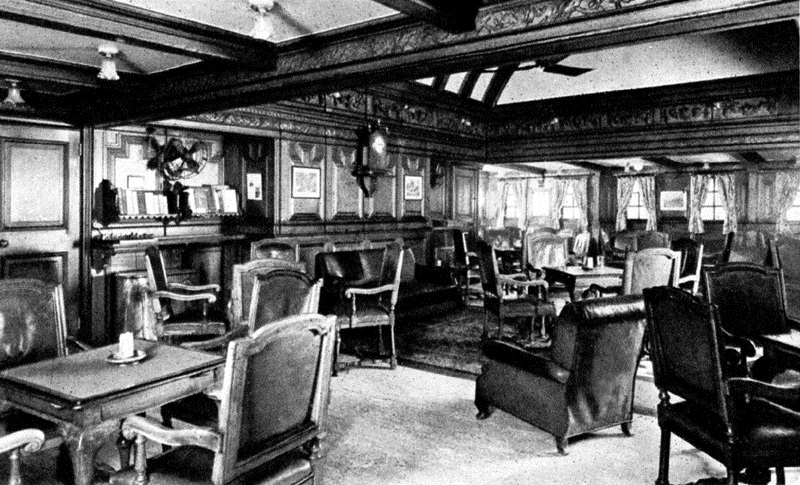
The Smoking Room was richly decorated and the walls clad in rich timbers, and there was a great deal of woodcarvings in the room.
Sent in by Chris
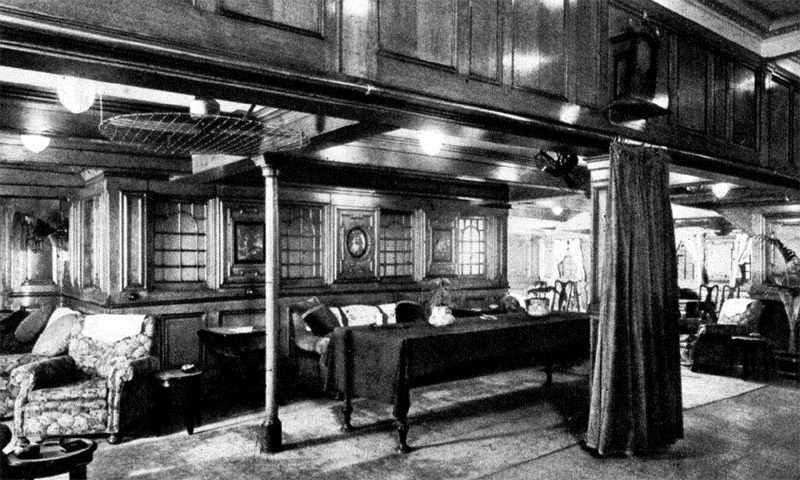
The Saloon had a raised ceiling in the centre. It was a rather heavy and in parts a dark venue, but near the windows there was far more light and with the comfortable furnishings, it proved to be more comfortable.
Sent in by Chris
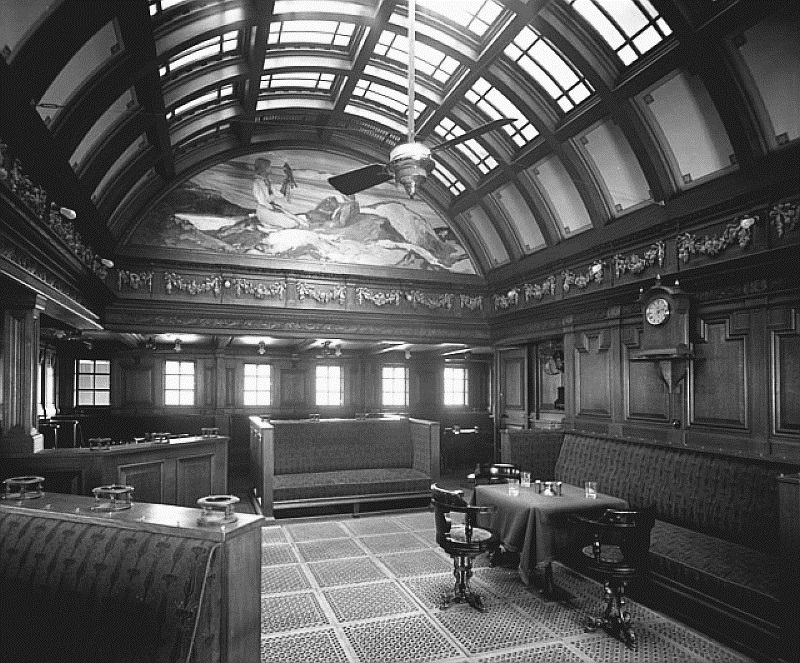
Here we see a much smaller new Saloon after her 1926 refit.
Photograph kindly provided by Jason Bonner
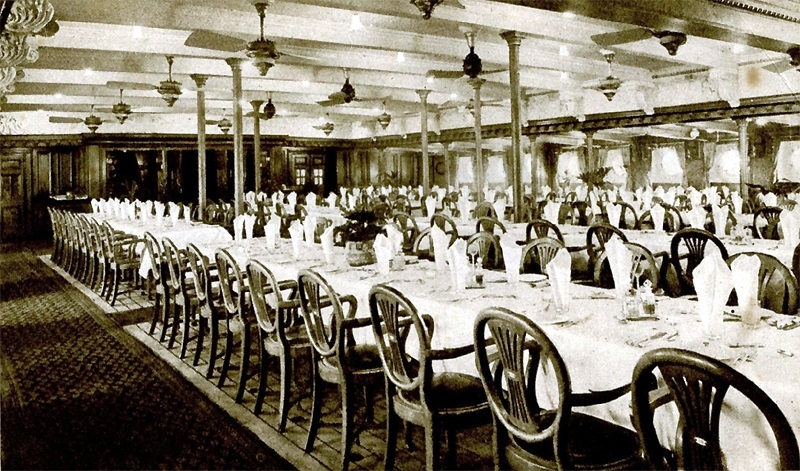
The Dining Room is typical of the 1920's; having long tables rather than individual ones was considered as being superior.
Sent in by Chris
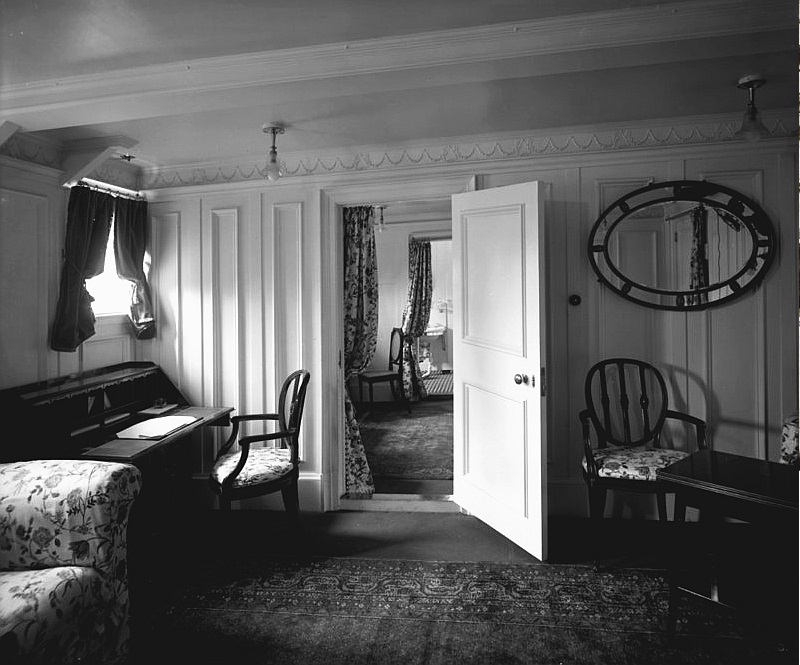
The Deluxe Suite had a good number of rooms, such as a lounge, dinning room and the main bedroom. There was also an additional cabin available for a maid, butler or a travelling companion.
Photograph kindly provided by Jason Bonner
Services – Liner voyages and War duties
In 1916 the Kaisar-i-Hind commenced on the UK to Australia service and on her very maiden voyage all the way to Australia, she sailed from Plymouth but she broke a record sailing to Bombay in just 17 days, 20 hours and 52 minutes. She continued via Colombo and Fremantle (Perth), Melbourne to Sydney and after a short stay returned to the UK. She made a number of such voyages until around 1921. She transported countless Australians during WWI and she is a much-loved ship Downunder and there are a number of reminders to her around the country! However she spent the vast majority of the War on trooping duties sailing mostly to the Mediterranean regions transporting British, Indian as well as French troops.
During her wartime voyages she certainly became known as the lucky ship for she had torpedoes aimed at her and fired directly at her, however amazingly, she survived all of them. We may ask; how could that happen? To be honest, the Germans had no idea of the Kaisar's speed ability and they tended to calculate her speed based on all the other P&O ships. A massive mistake for the Germans to make, and good fortune for the great Kaisar-i-Hind and extremely lucky for P&O! It was on five occasions she would be targeted by the Krauts, and torpedoes fired at her all missed! Here are the details.
With the Viceroy of India, Lord Chelmsford and his family on board, whilst she was sailing between Crete and Malta on March 23, 1916 the torpedoes fired at her all missed and she sailed at her top speed and managed to get away.
Thereafter she had three more similar misses, but, it had not finished yet for as you know I did mention that there were five times that submarines would fire torpedoes at the Kaisar. Apparently, according to the company records the last time she was actually fired at, she was hit in March 1917 by a torpedo, however for some reason the warhead just failed to explode and penetrate the ships lucky plates, thus it just bounced off. It was said that the ships speed and angle had much to do with that, but not the failure of it not exploding, thus it was the very first torpedo to actually hit but amazingly it simply failed. In addition, it was also the last torpedo sent her way for the rest of the war!

Laden with additional lifeboats the HMS Kaisar-i-Hind arrives in Melbourne during the War as a trooper. However, she was still carrying a certain number of passengers.
Photograph sourced from State Library of Victoria / picture number gr001405
However with World War I continuing her regular voyages were soon interrupted, as the ship was requisitioned by the Royal Navy to be used as a transport ship. She received a rapid transformation to be able to carry a good number of troops, yet she retained some First Class accommodations for and venues for a few passengers, VIPs and high-ranking officers etc. Additional lifeboats were added, thus all, but two were double banked. During this time she would carry Australian, British, French & Indian troops operating services to and from the Middle East, India and other war arenas.
Towards the end of the war she carried on of the most famous servicemen that fought in the Middle East, Colonel Thomas Edward Lawrence, or as he is also known, Lawrence of Arabia. For his story and other servicemen, passengers and crewmembers go to Page Two!
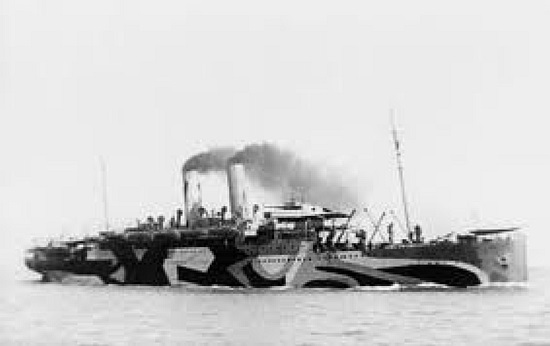
Here is a rare photo of the HMS Kaisar-i-Hind seen in her special camouflage livery
Source of the photograph is unknown having been sent in by a supporter
In June 1921 the RMS Kaisar-i-Hind was chartered by Cunard Line and she was renamed SS Emperor of India. Cunard would operate her on a number of Trans Atlantic voyages from Southampton to New York, however, considering that she had been built exclusively to operate in warmer waters and climates and she was certainly not suitable for the cold and rather rough north Atlantic and worse still Cunard was going to use her at the very worst time, late December, therefore the Kaisar-i-Hind was obviously the wrong ship for them and why they ever chose her simply is beyond me!
For the first time ever in her history, the wonderful and much loved Kaisar-i-Hind was extremely unpopular with her passengers, for she did not have a single sheltered deck to promenade on, which was the case on all Cunard liners! In addition, a great deal of fog interfered with her schedule during this time and this caused her further problems, again this made booked passengers very unhappy, even though it was not the ship's fault!
During one voyage there was a tragic stokehold explosion and sadly it killed three good men, they were long serving Indian firemen. In addition four engineers were badly scalded. To say the least, Cunard made a total disaster of this charter for they used a ship that should never have been used in these conditions, for she was not built for it! Prior to their charter, all they did is look at her beautiful interiors, which everyone knows are a pure a delight, but she was a poor choice by Cunard Line and to be honest, P&O should have also known better!
Late in December 1921 she resumed her regular schedule sailing from London to Bombay under her original proud name RMS Kaisar-i-Hind. It was decided in 1926 that the old girl needed a comprehensive refit and thus she was given one and all her facilities were beautifully upgraded! Upon completion she was registered as being 11,518 GRT.
Thus having had that horrid stokehold explosion whilst under charter in 1921, she did have a further two incidents thereafter. On May 22, 1930, whilst sailing between Aden and Port Said she somehow lost her portside propeller. After a diver's inspection, she continued to London, although at a reduced speed and upon arrival she entered Dry dock for repairs.
The next occurrence occurred was on November 1, 1931, when the Kaisar-i-Hind dragged her anchor during a storm in Malta harbour and she collided with the Italian ship the SS Citta di Trieste and in consequence this ship rammed and sank several lighters nearby.
Prince of Wales sails
The Prince of Wales commenced his tour of East Africa by departing London on Thursday September 6, 1928 together with his brother, the Duke of Gloucester travelling overland and crossing the channel heading for Marseilles. There the boarded they boarded the RMS Kaisar-i-Hind and disembarked at Alexandria. Whilst in Africa, they visited Egypt, but also placed they had never visited before, such as Tanganyika and Northern Rhodesia and places that "were almost unknown to white men." But in order to head further south the Prince and the Duke boarded the British India steamer SS Maida bound for Mombasa on September 14, calling for a few hours in Sudan on the 17th.arriving in Mombasa on Friday September 28.

Whilst the Prince of Wales toured Africa in 1928 he sailed on the Kaisar-i-Hind
Here we see his accommodations; we see his bedroom, lounge, study & bathroom.
After months in Africa, King George had fallen very ill and the Prince of Wales boarded the cruiser Enterprise for a fast voyage home to be at his father's bedside. The Duke took the shortest overland route back, until he could reach a suitable ship.
In May 1932 she was one of six ships that went to the aid of the French liner Georges Philippar that was on fire in the Gulf of Aden. The Kaisar-i-Hind faithfully patrolled the waters in search of lifeboats and as well as life rafts, which they were told may be heading for the coast, but sadly none were found.
Whilst on her voyage back to London, the Kaisar-i-Hind made P&O's first ever call at the Port of Tangier on July 17, 1932. The reason for this was, as there had been the constant appeals from the local British community, Thus P&O decided to appease the community!
From her refit in 1926, and yet having those few incidents as mentioned prior the Prince of Wales story, the wonderful Kaisar-i-Hind continued to sail most successfully for another wonderful twelve years, but by the end of those years she was slowly beginning to show her age!
The End of a fine Liner Arrives
The RMS Kaisar-i-Hind arrived at Plymouth on April 21, 1938, but what shocked many was that she was flying a long 72ft – 22m paying-off pennant, which I believe was the very first time this was done by a P&O liner. She departed that day and arrived at the King George V Dock in London the next day, being her very last arrival and her last passengers landed sadly her days were over. The truth was that the directors of P&O had already decided to dispose of the aging liner!
Sadly at age of 24 years, which for those times was quite considerable, the Kaisar-i-Hind was sold (on April 26, 1938) for £28,500 just two days after her arrival in London. The buyers were Hughes Bolckow Ship breaking Co Ltd, and with the same speed, she would ready to depart London for the breakers at Blyth.
The greatly loved RMS Kaisar-i-Hind headed for the Hughes Bolckow Ship breakers yards at Blyth, England.
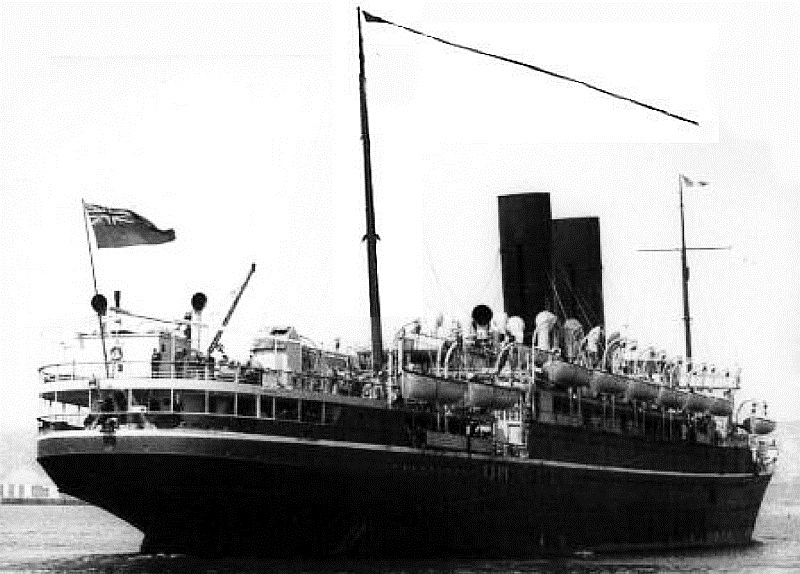
RMS Kaisar-i-Hind departs Tilbury Dock (London) for the very last time and she is flying a 72ft – 22m long pennant denoting her many years of service!
It is believed that this type of pay off pennant was used for the first time ever for a liner.
Photograph from the author's private collection
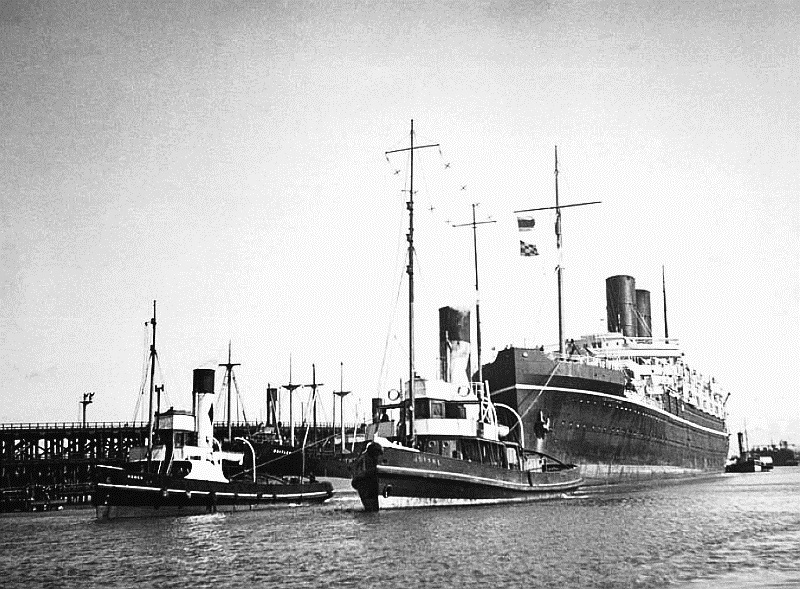
Tugs tow her into the breakers yard at Blyth.
Photograph sent by a supporter, but possibly taken by a "T Lister"


